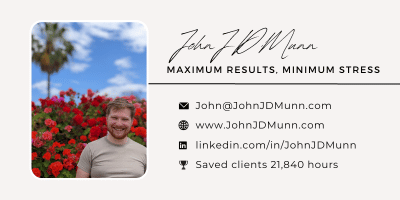🎯 Work Smart Wednesday - February 28, 2024
Make life easier with a 'kind learning environment', how I use data, and a quote on awareness
Work Smart Wednesday
👋 Hey there!
Here is your weekly dose of Work Smart Wednesday
In these emails I will share with you 3 things to help you work smarter in 3 minutes or less. That leaves you with 10,077 more minutes to conquer your goals this week
🎁 Receive rewards for referring your friends 🎁
📩 My favourite template to boost your business (1 referral)
💌 Shout out for you and your business in Work Smart Wednesday (7 referrals)
🎉 A full 1-1 strategy session with me (15 referrals)
1. 🤗 A Kind Learning Environment
A longer one, but worth it. Ties into the second, shorter, point.
When I ran my first real business, the first brewery in the world to specialise in ancient recipes, I had a pretty good grasp of how things were meant to work.
I had a degree in Management and Marketing from the #1 university for that course in Europe, a family member who was a maltster, and two self-made multi-millionaire mentors one who had made their money as a major investor in FMCG businesses and the other as the founder of world-renowned brewer of Hobgoblin Wychwood brewery. Things looked good.
Unfortunately, I quickly discovered that things in real life don’t necessarily work how the theory suggests.
Theory is often based on ‘perfect information’, a clear knowledge of what the current situation is. In business, the information we have is often murky or missing.
While most theory didn’t help, a theory did actually help me solve the problem. Meet “Kind Learning Environments”.
Kind learning environments have 4 criteria:
Relevant data is available
Relevant data is trustworthy
The rules don't change
Feedback is available quickly
Chess is a very good example of a kind learning environment. The rules are fixed, it happens in front of you in reality, and you know relatively quickly whether the move you made was good or not.
Unfortunately, business is a “wicked learning environment”. Rules change, incorrect or missing information is common, situations don’t repeat, feedback is delayed, and data can be ambiguous and misleading.
So how did knowing the theory of kind learning environments help me?
Like most things in life, whether the learning environment is kind or wicked is a spectrum. We can make the business environment much more kind by using data.
I might not be able to get perfect information, but I can certainly improve my access to timely trustworthy relevant data. I can regularly request feedback, and make it easier to obtain feedback quickly. I can help establish fixed rules by focusing on one small area at a time.
I always use data to inform my decisions, and actively encourage clients to improve their access to data. It takes a bit of set-up, but improving your learning environment makes it much easier and quicker to improve.
ACTION: Write out your data points (10 minutes)
Where do you currently get data from? What data do you have available? Is that data trustworthy? Is it quick? How can you make your data better?
Better does not necessarily mean more. A few key metrics tracked properly is better than an overwhelming amount of data that takes hours to collect and collate.
The first step to solving any problem is building awareness. We need to start by knowing what data you currently have access to. We can build from there.
2. 📊 How I use data
I am a fan of creating simple scorecards and minimal KPIs. It helps me benefit from the kind learning environment I created for myself and my business.
What 3-5 stats can tell you exactly whether things are going well or poorly in under 60 seconds?
Running a business is difficult. There is a lot of information you need to understand and take action on. If everything is visible in one place, it is hard to focus on the things that are important.
Odd analogy, but a mass of information hampering decision making and performance is one of the main reasons prey animals form herds. Bunching lots of similar things together in one place makes it incredibly difficult to focus.
To avoid analysis paralysis, I like to create simple overviews. I can then deep dive into more specific stats as required to fix problems or improve performance.
The core stats I track? Revenue, Customer Acquisition Cost, and Customer Lifetime Value. For product businesses I like to add net profit percentage. Everything else is simply data that feeds into one of these 4.
ACTION: Make a basic scorecard (7 mins)
You don’t need anything fancy, or even any integrations. Just create a basic document, spreadsheet, or grab a piece of paper. We can start by tracking these stats manually each month. How to calculate each stat is included on the hyperlink.
When you get into the habit of tracking and you find it useful, then we can look into automating that data collection.
3. 💡 Quote I'm pondering
"People generally see what they look for, and hear what they listen for.” - Judge Taylor, To Kill A Mockingbird
When it comes to facts, your opinion doesn’t matter. Opinions are important and they do help us make better decisions, but we also need to know what the facts are.
Unfortunately, you and I (and all humans) have a whole load of unconscious biases. We want to try our best to reduce the effect our biases have on our decision making and to get the most objective data possible. But that is difficult.
Having a trusted and experienced independent external person to look over things helps, but we want to ‘clean’ our data as much as possible regularly too.
That's it! I can't wait to hear what you think. What did you find most useful? What do you want more or less of? Reply to this email now and let me know
I adapted the style this week, with bolded action points. Your feedback would be much appreciated - how do you feel about the change? Email me at John@JohnJDMunn.com
Also, if you have anything interesting to share, I want to know about it😊
Have a great week,
John
P.S. Did someone forward this to you? Subscribe here
P.P.S. Thank you for trusting me with your time. If these emails ever turn into a burden, I encourage you to unsubscribe. I strive to provide real value and I am here to help you to make the most of your time
👋 Want to work together?
When you’re ready, here are 3 ways I can help you:
🔍 Clarity Call - we will discuss your situation and create a step-by-step action plan together so you know exactly what you need to do next for maximum impact
👓 StartSmart - Achieve a 6 figure income within 6 months, whether you only have an idea or you have already started your business
🧘 Overload to Optimal - reduce your workweek to 20 hours or less within 90 days while running your 6-8 figure business
Enjoyed this issue of Work Smart Wednesday?
Refer a friend to sign up and earn valuable rewards







